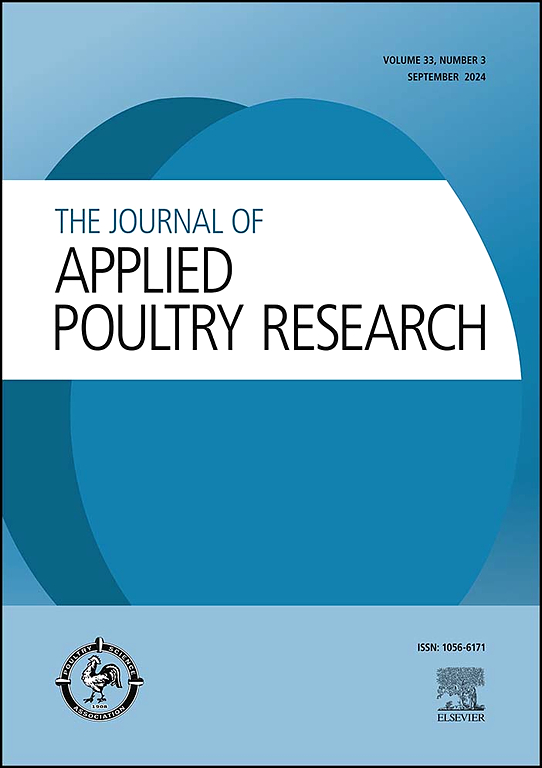通过定量超声波、三点弯曲试验和灰分含量比较蛋鸡的骨骼质量
IF 1.6
3区 农林科学
Q2 AGRICULTURE, DAIRY & ANIMAL SCIENCE
引用次数: 0
摘要
本研究旨在比较两种定量超声波(QUS)设备的性能,并研究用声速(SOS)测量的骨密度与骨的生物力学特性之间可能存在的关系。使用两种 QUS 设备测量了 46 只饲养在传统笼子里的 29 周大蛋鸡的肱骨和跗骨的骨密度。测试结束后,对这些蛋鸡实施人道安乐死,并收集它们的左胫跗骨和跗跖骨。在中轴处测量这些骨骼的直径。使用 TA-HD Plus 仪器评估弯曲力矩和峰值力。统计分析在 JMP Pro 16 中进行。所有分析的显著性均设定为 P<0.05。两种设备的 SOS 结果一致性较差。弯矩和峰值力之间存在中等程度的正线性相关(r2 >0.6)。在骨直径与弯矩或峰值力之间,以及在 SOS 或骨灰含量与所测得的任何机械性能之间,均未观察到明显的线性相关。采用名义逻辑拟合模型比较低密度与正常骨密度与生物力学特性之间的关系。如果骨骼的 SOS 低于平均值的 1 个标准差,则该骨骼被定义为低密度骨骼。将所有三种生物力学特性联系起来的模型(P = 0.0173)与胫骨的密度(低密度与正常密度)有显著的相关性。此外,弯曲力矩较大和峰值力较小的母鸡跗跖骨出现低密度胫骨的几率比较大(P = 0.0293)。这项研究未能证明 SOS 与骨骼生物力学特性之间的关系。虽然 QUS 是一种无创评估方法,但这些设备与骨骼的机械或灰分含量之间的关系微乎其微,甚至没有关系。需要对无创工具进行测试和验证,以扩大我们对骨骼健康的了解,并在纵向研究中对蛋鸡群的骨质流失进行早期检测,从而制定有效的管理和干预策略。本文章由计算机程序翻译,如有差异,请以英文原文为准。
Comparison of bone quality in table egg layers by quantitative ultrasound, 3-point-bending test, and ash content
This study aimed to compare the performance of 2 quantitative ultrasound (QUS) devices and to investigate the possible relationship between bone density, measured by speed of sound (SOS), and the biomechanical properties of bone. The bone density of humerus and tarsometatarsus of 46, 29-week-old laying hens housed in conventional cages were measured with 2 QUS devices. After testing, the birds were humanely euthanized and their left tibiotarsus and tarsometatarsus were collected. The diameter of these bones was measured at mid-shaft. Bending moment and peak force were evaluated using a TA-HD Plus instrument. Statistical analysis was performed in JMP Pro 16. For all the analyses, significance was set at P< 0.05. There was poor agreement in the SOS results between both devices. There was a moderate positive linear correlation (r2 > 0.6) between bending moment and peak force. No significant linear correlation was observed between the bone diameter and the bending moment or the peak force, or between SOS or bone ash content and any of the mechanical properties measured. A nominal logistic fit model was used to compare low vs normal bone density to the biomechanical properties. A bone was defined to have low density if its SOS was below 1 standard deviation from the mean. A model that linked all 3 biomechanical properties (P = 0.0173) was significantly correlated with the density (low vs normal) of tibiotarsi. Furthermore, the hen's tarsometatarsus with a higher bending moment and lower peak force had an increased odds ratio of low density tibiotarsi (P = 0.0293). This study failed to demonstrate a relation between the SOS and biomechanical properties of bone. While QUS was noninvasive assessment, the devices provided minimal or no association with the mechanical or ash content of the bones. Testing and validation of noninvasive tools are needed to expand our understanding of bone health and offer early detection of bone loss mass in layer flocks in longitudinal studies to develop effective management and intervention strategies.
求助全文
通过发布文献求助,成功后即可免费获取论文全文。
去求助
来源期刊

Journal of Applied Poultry Research
农林科学-奶制品与动物科学
CiteScore
4.10
自引率
10.50%
发文量
80
审稿时长
104 days
期刊介绍:
The Journal of Applied Poultry Research (JAPR) publishes original research reports, field reports, and reviews on breeding, hatching, health and disease, layer management, meat bird processing and products, meat bird management, microbiology, food safety, nutrition, environment, sanitation, welfare, and economics. As of January 2020, JAPR will become an Open Access journal with no subscription charges, meaning authors who publish here can make their research immediately, permanently, and freely accessible worldwide while retaining copyright to their work. Papers submitted for publication after October 1, 2019 will be published as Open Access papers.
The readers of JAPR are in education, extension, industry, and government, including research, teaching, administration, veterinary medicine, management, production, quality assurance, product development, and technical services. Nutritionists, breeder flock supervisors, production managers, microbiologists, laboratory personnel, food safety and sanitation managers, poultry processing managers, feed manufacturers, and egg producers use JAPR to keep up with current applied poultry research.
 求助内容:
求助内容: 应助结果提醒方式:
应助结果提醒方式:


